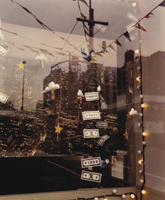Max Kozloff, once the executive editor of this magazine, is best known for his writings on modern art. Much of this work has explicitly focused on photography, a subject upon which he has trained his formidable intellect almost exclusively since the mid-1970s, publishing three collections of essays, organizing museum exhibitions, and contributing to numerous artists’ monographs. In that time, he has also been an active photographer, using the camera to capture first the environment and then the citizens of his adopted hometown. This show, wryly titled New York Means Business, collected twenty-five images taken between 1977 and 1984, nearly all depicting storefront window displays.
As Kozloff readily admits, he was working at the time under the influence of Eugene Atget, whose efforts were ostensibly documentary in nature and have been interpreted as recording the final remnants of Old Paris. During the last three decades, finance capital has rewritten the built environment in New York as radically as the abstract forces labeled œmodernity upended nineteenth-century Paris. Seeing Kozloff’s pictures now, one appreciates their documentary value: Old New York, once visible to any anyone walking in the streets who cared to notice, is now mostly gone. As Kozloff had already presciently noted in 1986, a familiar corporate sterility in New York would replace the zipper and twine shops, the pawned-watch purveyors, and the other idiosyncratic and independent enterprises he diligently captured with a lens.
Kozloff is interested not only in his subjects’ intrinsic worth, but also in their relationship with the semitransparent reflections of urban fragments caught in the windowpanes. Befitting his long fascination with photography, such juxtapositions allow him to engage self-consciously with historical precedents and to experiment with representational possibilities. The complex interplay of reality and reflection is paramount in Antique Store With Engraved Mirrors, 1978, in which the titular items, haphazardly arranged, capture objects from all directions—a passing taxi, an upper-story apartment window, the underside of flowers in a crystal vase—but, somehow, not the photographer himself. New York Under Glass, 1981, is also exemplary, dizzy with referents, portraying reflected apparitions floating in a space of indeterminate depth. Near the back of this complex image hangs a poster of midtown Manhattan in the evening, the skyscraper windows glowing yellow like kernels on a corncob. As Kozloff surely knew, the poster is reminiscent of a 1932 photograph by Berenice Abbott taken from the Empire State Building’s then-new observation deck. But such elevated, glorifying vantage points are not for
Kozloff, who celebrates the streets, so the soaring midtown high-rises are overlaid with the reflection of unfussy mid-rise apartment buildings in the immediate vicinity. The storefront glass likewise reflects pennants hanging from a street lamp, which slice dynamic lines across the composition, as does a string of lightbulbs framing the poster. In the midst of all this falls a shower of fake currency, tens and twenties and hundreds, a metaphor of the force behind the changes Kozloff was witnessing around him. Kozloff has written that Atget dramatized a historical process in his immense body of work, and the complex symbolism of New York Under Glass achieves something similar. Among other theses, Kozloff’s 2002 curatorial effort New York: Capital of Photography contended that street photography is uniquely able to capture a city that shuffles, obliterates, and reconnects appearances at will. With its lost world so artfully staged, this exhibition made clear that he was arguing from experience.

